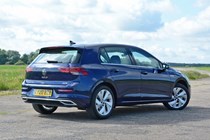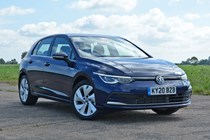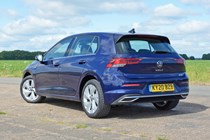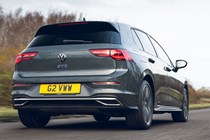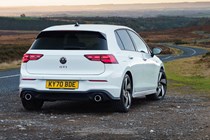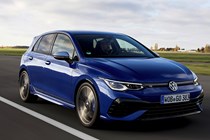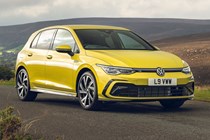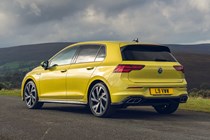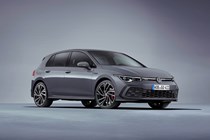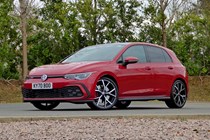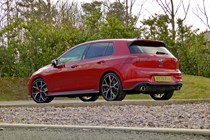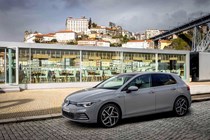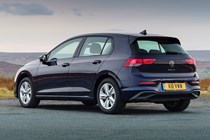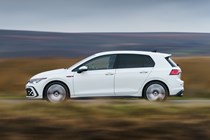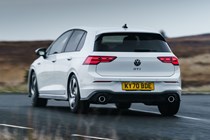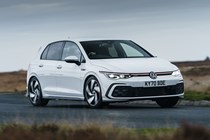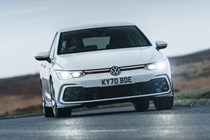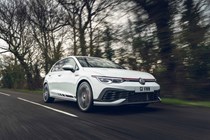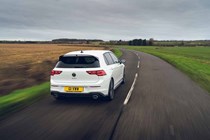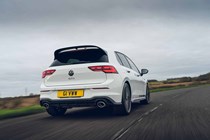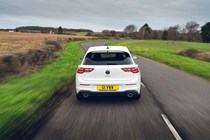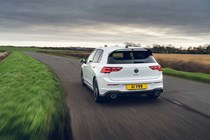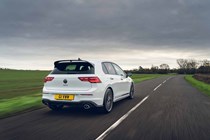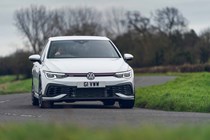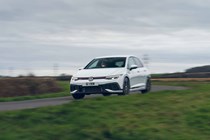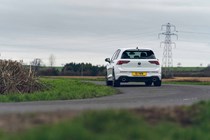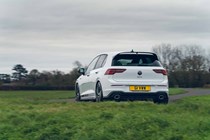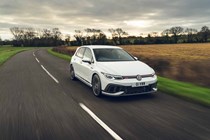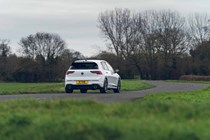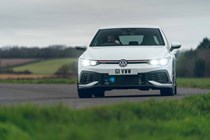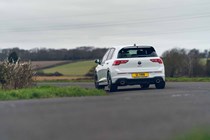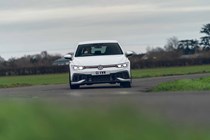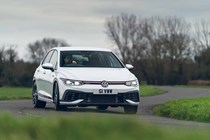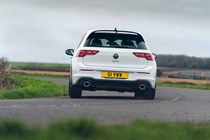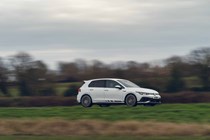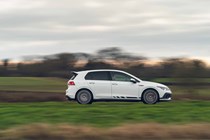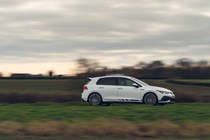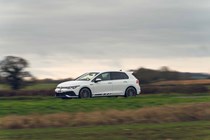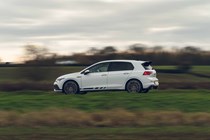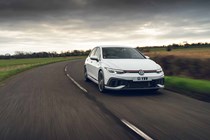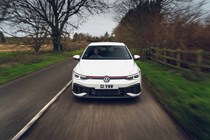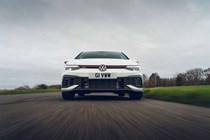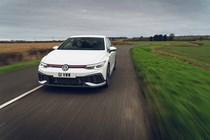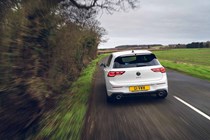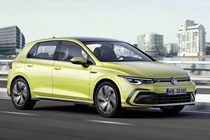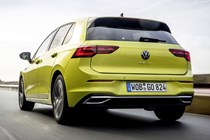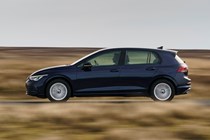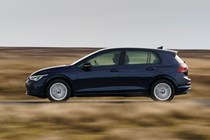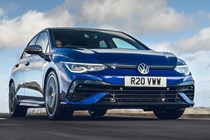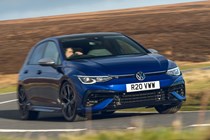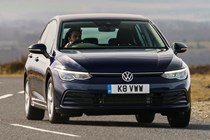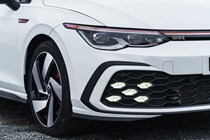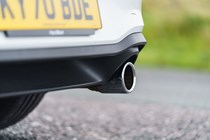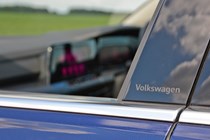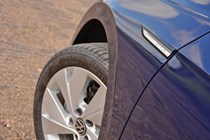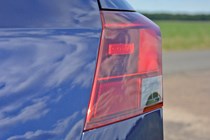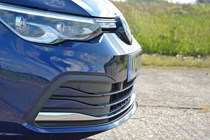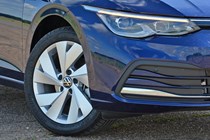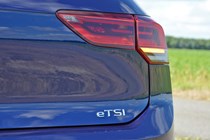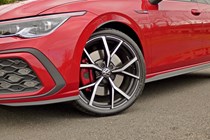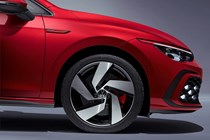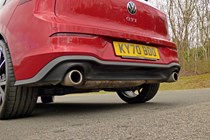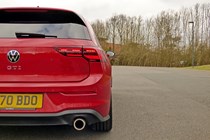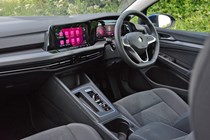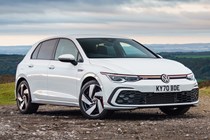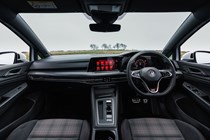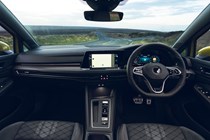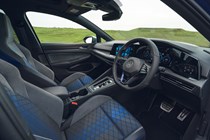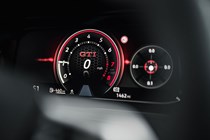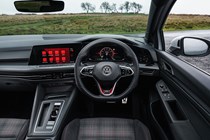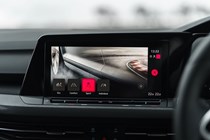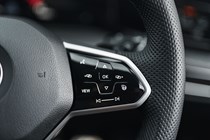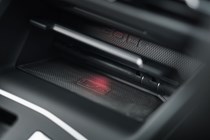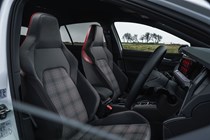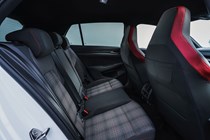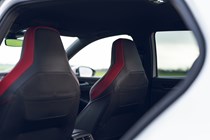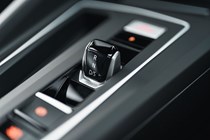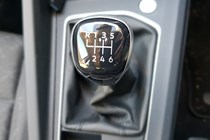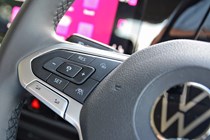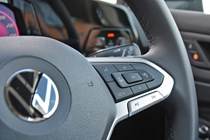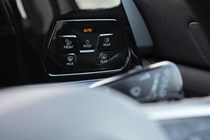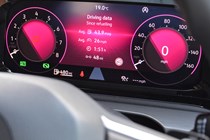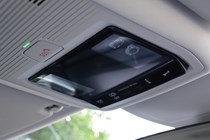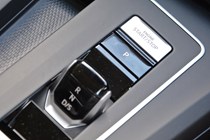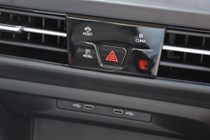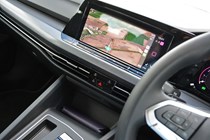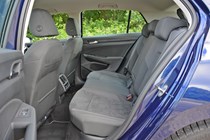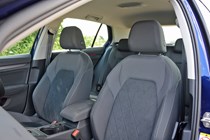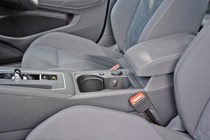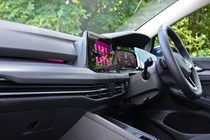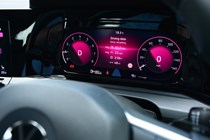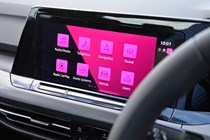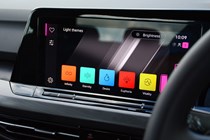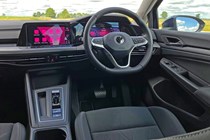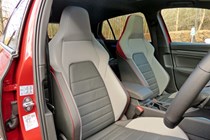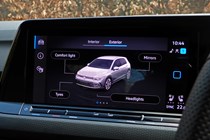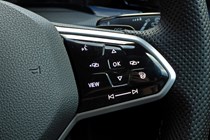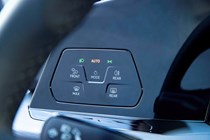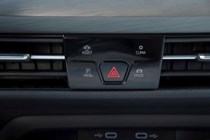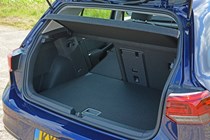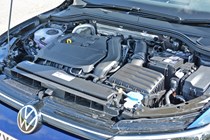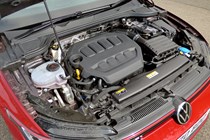
Volkswagen Golf long-term test
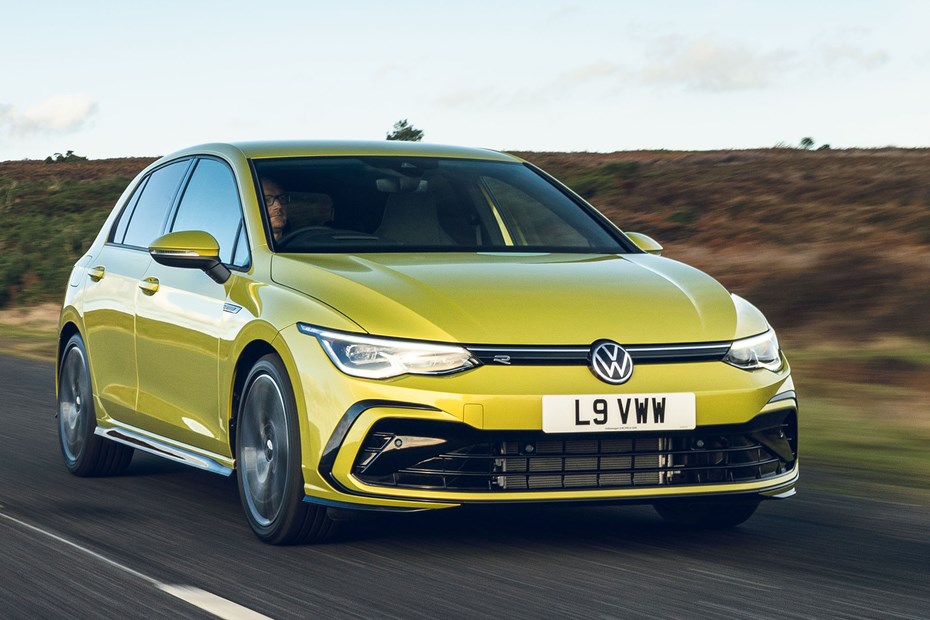

Fancy a brand new Volkswagen Golf 8 after lockdown? We’ve got one for six months – follow our journey and experiences here..
Report by Percy Lawman – Senior Product Content Manager
Jump to:
- Update 2: Interior and safety
- Update 3: Driving, performance and handling
- Update 4: Buying, owning or hiring your Golf
- Update 5: Second opinion
- Update 6: Roundup plus what we like and don’t like
Update 1: Introduction
I can’t think of a better car to cuddle up and get intimate with after 14 months of lockdown than a real family favourite – the VW Golf. While it’s not been around quite as long as the post-war forces radio show, it probably has as many, if not more, enthusiastic followers.
The Golf is now in its eighth iteration and is battling for the honours in one of motoring’s most hotly-contested arenas.
Mention the word ‘family hatchback’ and hard-hitting gladiators like the Ford Focus [which won Parkers ‘Best Small Family Car’ in the 2020 New Car Awards], Mercedes-Benz A-Class, Skoda’s Octavia and the SEAT Leon are familiar names that frequently slog it out and jostle for the top trophies so it’s a blisteringly-hot and intense place to be.
My new partner for the next six months is KY70 BHA, a 1.5 TSi 150 Golf R-Line [2021 model year], with a six-speed manual gearbox and finished in a wonderful ‘Moonstone Grey’ colour guise. It’s nothing like ‘Battleship Grey’ but has an intense zing about it. Parked outside on the drive, early impressions from passers-by seem to be very encouraging – the colour is the most talked about aspect and always in a positive light. When in town it seems to be a frequent head-turner.
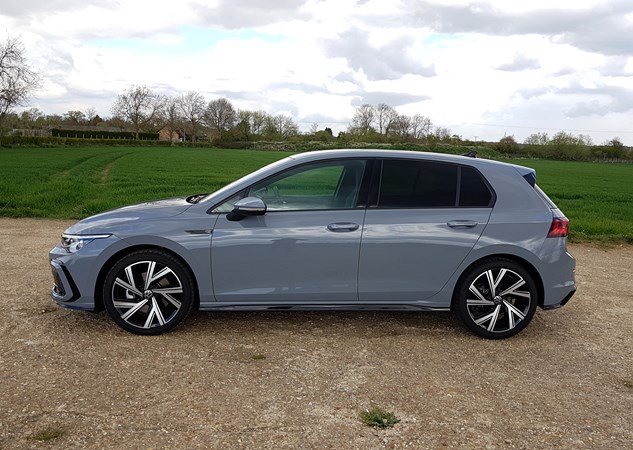
Coupled with the great colour scheme, the car is fitted with some of the lowest profile tyres I’ve seen for a while. All four wheels sport premium Bridgestone ‘Turanza’ 225/40 R18 rubber which are fitted to optional 18 inch ‘Bergamo’ alloys.
This makes for a really low profile and there’s only a couple of centimetres from the tarmac to the rim edge. Even so, there’s plenty of fresh air between the tyre and the wheel arch should you hit that dreaded pothole and give the suspension system a work out. Yes, it sits very low and certainly looks the part but owners should be aware and steer clear of those dreaded high kerbs.
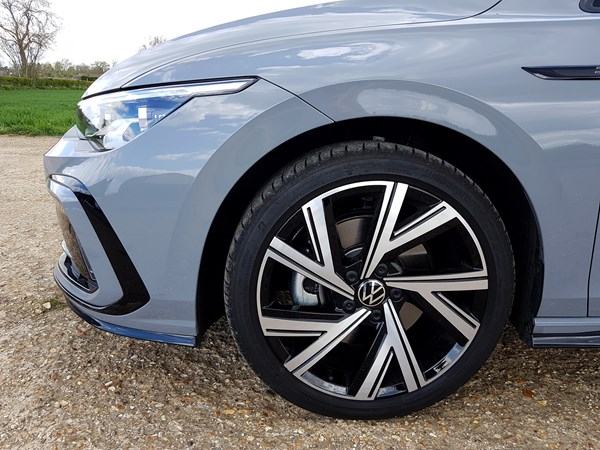
Whilst we are talking options, our Golf brags an additional rear-view camera, climate control, head-up display, IQ LED ‘Matrix’ lights, winter pack, digital key prep and DCC [Dynamic Chassis Control]. The later I’m looking forward to seeing how the Golf can pick its way a multitude of driving scenarios from potholed back roads to fast ‘A’ roads and sweeping corners. It certainly promises to be a great ride!
Whilst I’ve yet to take the car on any really serious jaunt, a brief run down the A1 on a 100-mile round trip gave me my first initial driving impressions. As big alloys and low-profile tyres were the order of the day, the car as expected, liked the ‘fast-road’ scenario. It felt brisk but not quick, probably not helped by a brand new ‘tight’ engine and big wheels. The engine required a reasonable amount of work to achieve the desired result. Normally, new engines loosen up and become more responsive after a few thousand miles have been covered and we’d expect the same here.
Road noise was manageable but the chunky tyres and big rims made for an increase of a few dB’s but nothing that was difficult to live with. We’ll report back more in a future update when we’ll test the DCC in more varying and aggressive environments – especially those great UK potholed backroads.
We’ll also be cramming plenty of shopping into the not-so-large boot. Even so, at 381 litres it’s over 100 litres larger than the Ford Focus at 273. When you’re not talking huge amounts of space, 108 extra litres can’t be sniffed at.
All-in-all the Mark 8 Golf looks to have got off to a great start and on the surface seems to cementing its place again into family hatch history. It’s jam-packed with modern tech and during the next six months we’ll enjoy getting under the skin of one of the country’s most popular cars, finding out what we like and what doesn’t quite hit the mark.

Update 2: Interior, equipment and safety
Percy Lawman tried to get under the skin of his new Volkswagen Golf and get to grips with all the new tech…
Focal point of the Golf Mk8’s cabin is the inclusion of a 10.0-inch ‘Digital Cockpit Pro’ display which is complimented by a central display [also 10 inches in size] for the infotainment and ‘Discover’ navigation screen. Both of these are standard fit on all UK models. Commonly called a ‘Virtual Cockpit’. VW refer to it as ‘Innovision’. VW replaced the analogue display of dials and buttons when the previous MK7 Golf was facelifted in 2017 so from then on it was a truly digital love affair.
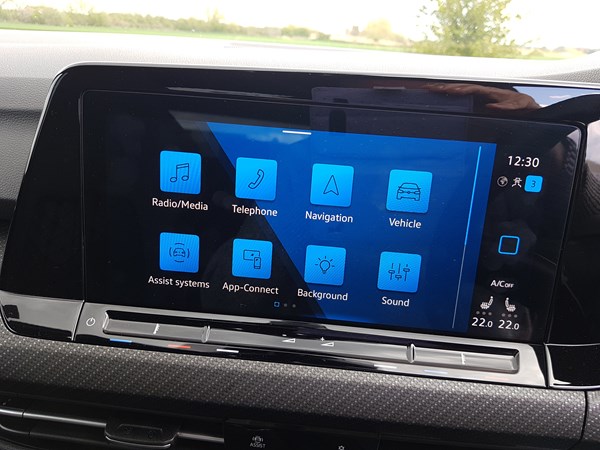
The ‘Discover Navigation System’ includes a capacitive 10-inch screen with touch-sensitive functionality. European nav data is loaded as standard with branded points of interest, 2 or 3D map view, speed limit display, car data display to name just a handful of user goodies. The in-built radio is fully DAB, includes six speakers with an output of 4x20w.
Media playback includes old favourites such as MP3, WMA and ACC files complete with music title and cover art. The screen works very well and in typical VW fashion is very intuitive. Even with sticky hands on a hot day, the screen didn’t give any real concern although touching it whilst travelling [especially on a bumpy road] occasionally required a ‘second’ or subsequent attempt which could cause a minor distraction.
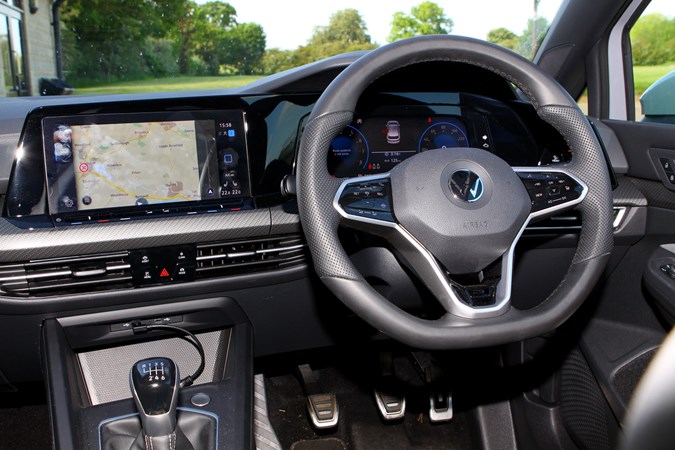
Personally, I found the menu system was pleasant to use, however there’s a lot of personal views around the media and users alike so it’s all very subjective. I thought on the odd occasion that some menus weren’t quite where I thought they would naturally sit, but were hidden deeper down in the depths of the digital abyss. When on the move, this makes for additional actions in order to navigate to the function you need. I found on some occasions that I [really] needed to stop and figure out [safely] how to find the required setting.
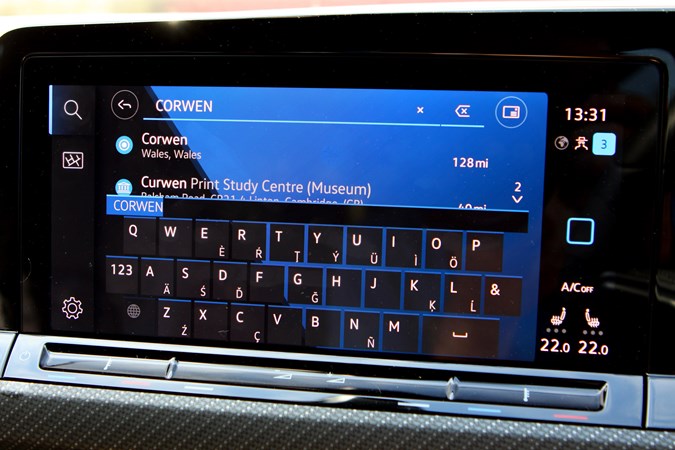
Smartphone users will be pleased to know that the ‘App Connect’ feature combines the functionality of Apple CarPlay, Android Auto and MirrorLink which allows the mirroring of your smartphone display onto the infotainment touchscreen which is really quite neat. Additionally, this can be done via wireless for Apple devices although various USB sockets are provided for other devices including a modern USB-C connector. I had no issues in connecting my pretty old Samsung Galaxy S4 up to the system and it was immediately recognised.
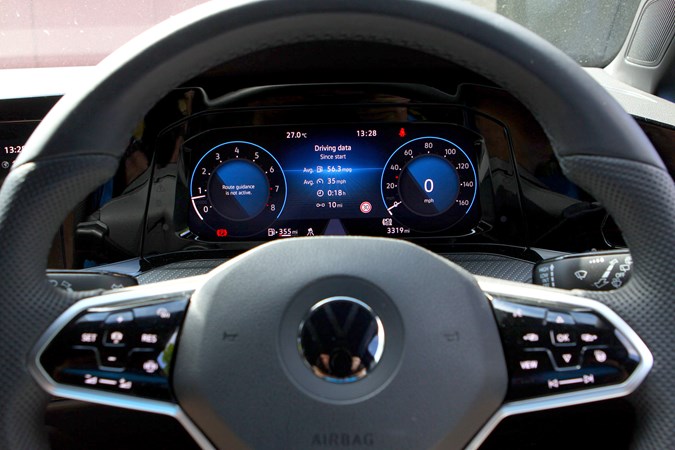
On the driver’s screen behind the steering wheel, the software driven display allows you to select three pre-defined layouts by using various thumb/finger-controlled push/rocker buttons located on the steering wheel. The buttons have a firm ‘clunk’ when operating but are easy to get used too.
This is about all you’ll see with regards to controls. You won’t find any big clunky manual toggle or rocker switches. The display is split into two dials, with the right-hand dial displaying MPH and the left a rev counter. Within each dial there are 16 separate options to display various car data and information so the permutations available to the user are many and it’s a powerful system to use.
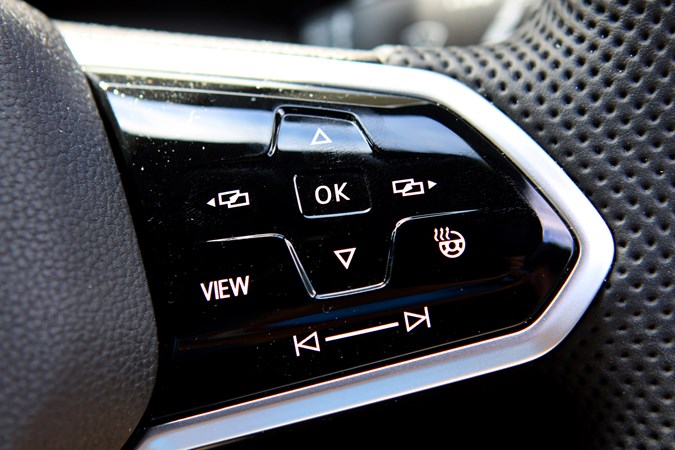
Aficionados of the older Golf ranges will notice that many of the interior buttons and switchgear controls have been removed having been replaced with sliders and touch panels for the majority of the vehicles’ key functions. There’s’ also an optional ‘Natural Voice Recognition System’ which amongst other things, can ‘Warm up the Steering Wheel’ if your hands are cold. The automation on the new Golf has certainly been extended to another level.
Talking of automation, VW now include a new package called Car2X which enables your new Golf to ‘Chat’ wirelessly to another equally fitted vehicle. It’s a sort of social media chit-chat for cars which means vehicles can share and exchange data such as traffic conditions and emergency situations amongst other things. This seems to be an EU influenced arrangement as it’s not manufacturer specific to VW so buyers can expect this type of technology to be on the increase in years to come whatever the make of your car. Time will tell as to whether users actually find this service useful or not.
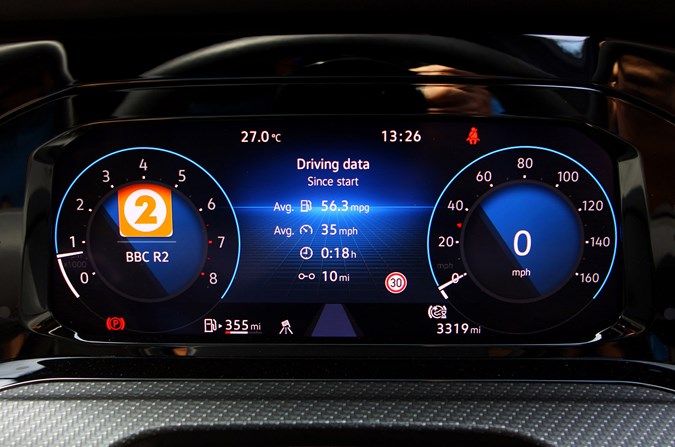
The new Golf leads the pack as it’s the only model in its class to provide LED lighting as standard. Our own ‘R-line’ car also has the optional advanced IQ.Light LED-matrix headlamps [£1750] which were first introduced on the Touareg. On the GTD, GTE and GTI Golfs – this kit is fitted as standard equipment. We’ll include a separate piece on the lights and how they perform in a later ‘Driving’ update.
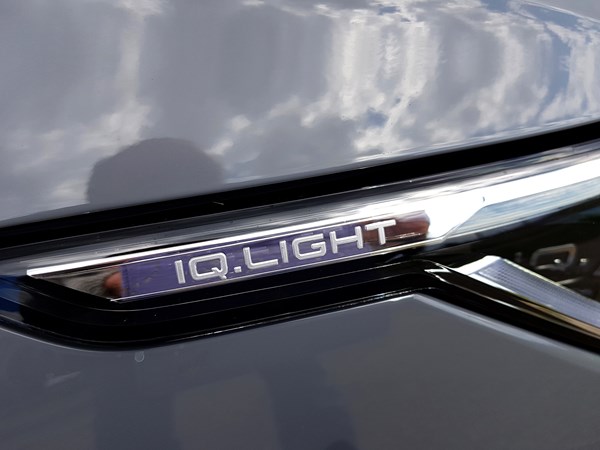
At the rear, boot space is better than some rivals such as the Ford Focus as mentioned earlier. Even so, a trip to the local supermarket only managed to squeeze in 7 bags of shopping. Doing a full family shop will be stretching the carrying capability of the Golf to its limits that’s for sure. Of course, if push comes to shove – then you can always drop the rear seats downs to give you nearly the same amount of space again.
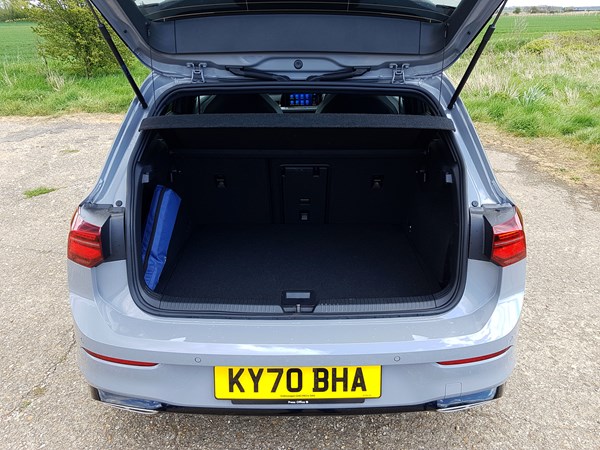
VW as a premium brand, are one of the top manufacturers when it comes to safety. The Mk7 Golf scored 5 stars in its Euro NCAP test way back in 2012. The Golf 8 follows in the same tradition scoring another 5 stars in the 2019 testing session with 95% and 89% for driver and passenger protection respectively making it one of the safest cars on the road today.
For passengers in the vehicle, there’s’ plenty of leg room and for 6-footers like myself, there’s no real worry about the amount of space in the rear. The rear also has its own dedicated climate control and air-conditioning which is accessible from vents at the rear of the centre console. Comfort-wise, the Golf is very comfortable. Now that lockdown is now officially ending, I managed to get about 1000 miles covered over the last two weeks and one thing that became very obvious is how extremely comfortable the Golf 8 is. I did a 300 miles stint on one journey [albeit on mainly fast ‘A’ roads and motorways] and there was no fatigue at all. It looks like the days of the ‘numb-bum’ are well and truly over [well for Golf 8 owners anyway]!
Inside the cabin for driver and passenger comfort, the ambient lighting allows a choice of 30 colours so you’re really spoilt for choice. Additionally, light strips extend across the dash, below the trim in the front and rear doors and in the front centre storage tray. The front footwell also includes subtle LED illumination. For those cold winter mornings, heated driver and passenger seats [Winter Pack Option – £270] keep those extremities nice and cosy and heated wing mirrors [Included] ensure you’re ice-free before you start your journey.
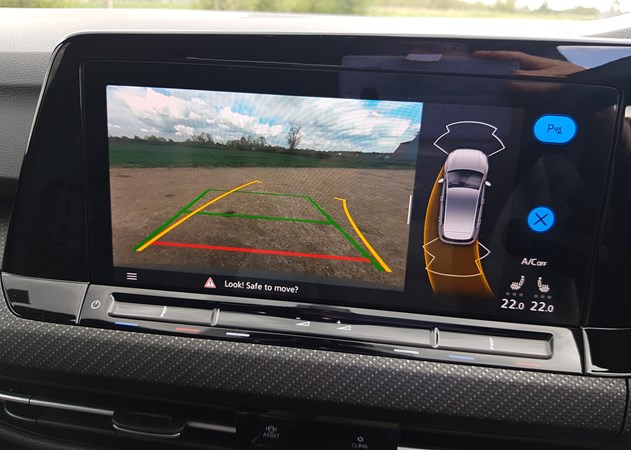
One option that’s fitted to our R-line spec car is the rear-view camera [£300] which is displayed through the infotainment screen. What I can say is the quality of the camera is extremely good. The manufacturer doesn’t seem to have sacrificed anything here and although there’s no indication of any technical data on the camera, resolution looks to be very good. OK it isn’t 4k but the images are crisp and sharp with good colour and contrast allowing you to accurately see the area you are reversing into.
The camera automatically reveals itself from under the VW badge on the boot lid when reverse gear is selected, a function that you can clearly hear in the driver’s seat. Likewise, put the car in first gear and travel about 100 meters and the camera decides it’s done the work required and resets itself, closing back up. All very neat and convenient.
Update 3: Driving, performance and handling
Time for Percy Lawman to turn his attention to how the Volkswagen Golf Mk8 drives…
With lockdown gradually ending, I’ve now had a chance to put our new companion through a few thousand miles of driving. With 4000+ miles on the clock, the engine is beginning to loosen up quite nicely making the car rather more responsive, especially in the lower and mid-range than it was back earlier this year.
I find it pretty nippy low down in the rev range, although the car still requires ‘working’ well through the revs to get the most out of it. Higher up the range, she requires a reasonable amount of input from the driver and currently I notice quite a linear response as the car encroaches the higher echelons of the rev range.
Out and about [and especially when parking up], I’m always been very conscious of the chunky 18-inch alloys and in the process – paying extra attention not to kerb any of them. Whilst on the subject of wheels and tyres, I found out whilst travelling briskly on the A1, I received an audible warning from the tyre pressure sensor which seemed to indicate that one [or more] tyres had suffered a puncture. I duly pulled over but on inspection everything looked ok. So, I made a for a slow cruise home, checking on the tyres every 10 miles or so but still couldn’t find any problem. A check on the pressures revealed all were within the factory recommended specification.
On further reading of the very comprehensive owner’s manual, owners are made aware that when a car is new [or a car that has been fitted with new tyres] it [may] possibly trigger a ‘false positive’ with the sensors as the new tyres expand. As the problem occurred whilst I was ‘Fast Cruising’ on the A1 and the tyres were only 1200 miles old – I put this extended non-stop run as being the culprit as nothing else seemed wrong.
The sensors were duly reset which is an easy on-screen operation and since then, the tyre sensors have behaved themselves with no further false errors.
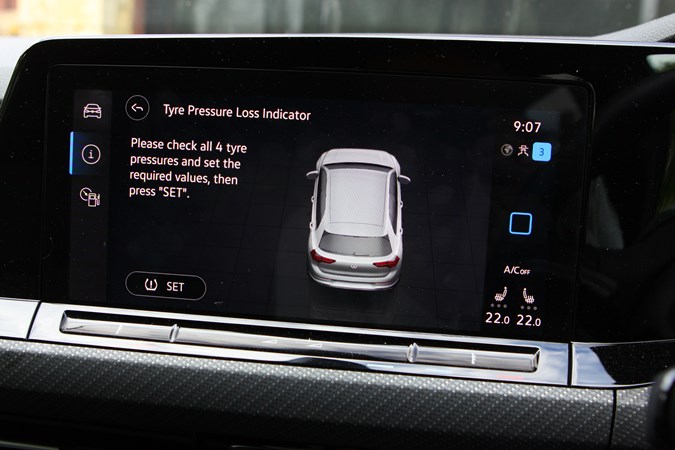
Our Golf Mk8 is fitted with the optional DCC [Dynamic Chassis Control]. In the owner’s manual it’s referred to as the ‘Adaptive Chassis Control’ and not to be confused with the ‘ACC’ which is the Adaptive Cruise Control and thus not related. So, lots of big funky words and some minor confusion, but what’s it all about and more importantly what does it do, how much does it cost and is it really worth the additional outlay?
The £785 DCC option allows the driver to select one of two ‘User’ settings to suit the driving conditions, these being ‘Comfort’ and ‘Sport’. The DCC itself is adjustable with software selectable settings on the screen. In essence the DCC has settings between 1 and 15. ‘1’ being the softest and will of course make the car absorb the bumps more so on uneven roads and ‘15’ being the hardest, best suited for fast road applications. By default, VW set the ‘Comfort’ on setting 4 and ‘Sport’ on position 12.
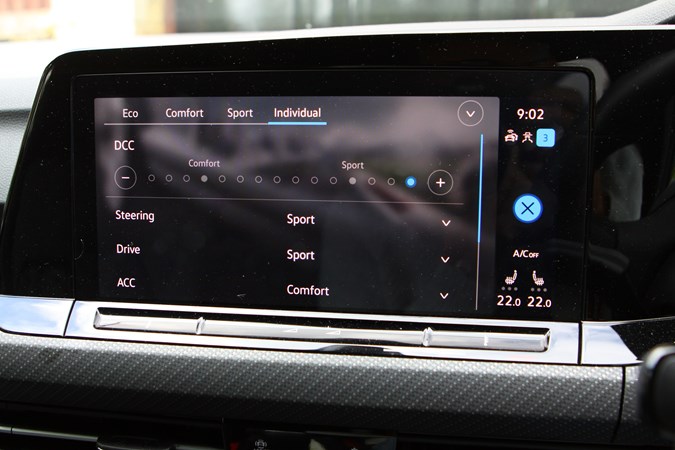
In real world driving you can notice a difference, especially during our summer afternoon test on some of the Fenland roads. My wife commented that she thought the drive was initially quite harsh. After telling her that the car had the DCC set to maximum [and what the DCC was all about], she said it would not be suited on that setting to a longer journey. Setting the drive mode to ‘Comfort’ changed the DCC also to setting ‘4’ and it made a big difference – so yes it works nicely. Slower bumpy roads had a much better feel when the ‘Comfort’ setting was enabled and the car had a distinct better feel to it especially as we have the optional 18-inch alloys fitted.
Whilst parked up I measured the amount of gap between the tyres and the wheel arch as I was curious to see if the DCC actually adjusted the ride height as well as the damping effect. Setting between ‘Comfort’ and ‘Sport’ saw no difference between the two and even setting the individual user selected settings to position 1 and then 15 respectively, didn’t visually change anything so the DCC is purely acting with, and electronically adjusting the dampers rather than changing any ride height setting.
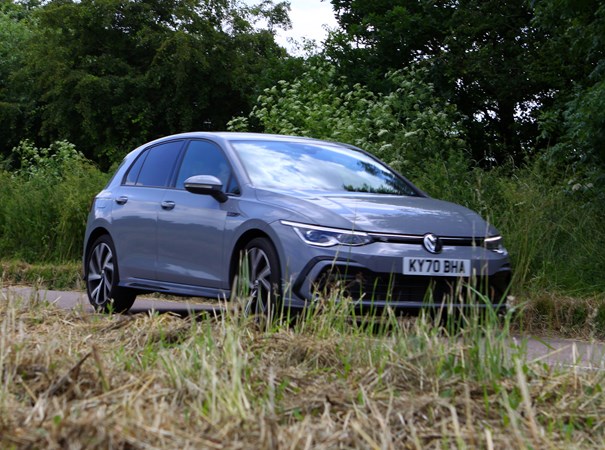
Out and about on much faster ‘A’ roads – here the DCC seemed to shine. I adjusted the setting to max [15] to get the best out of a firmer suspension setup, achieved by using the ‘Individual’ user setting and set everything to else to ‘Sport’ using the driver ‘Mode’ button. Here, the Golf started to handle more like a fast road/track car. Damping was much firmer and the car responded well when being driven at light-speed into fast and undulating corners.
You could tell that the damper was much firmer with a reduction in body roll [not that it has much originally] – so yes it works well. We think for owners who enjoy a certain amount of spice in their driving that the DCC is not an overly expensive option and gives a touch of that ‘Thrill Seeking’ experience. We’d recommend it as a useful additional option.
We know the DCC is also available on other VW models but we would question how useful it would be in something akin to an SUV [like a VW Tiguan] for instance. So, our thoughts are it suits our Golf very well and it has to be a must if you have the Golf GTi or Golf R.
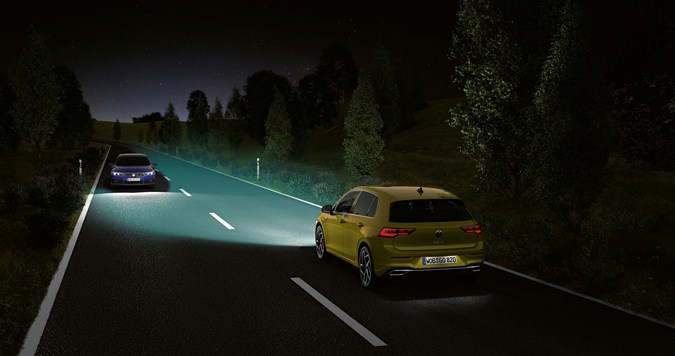
One of the other options fitted to our Golf is the ‘IQ. Light’ with LED Matrix headlamps. I was curious to see what advantages this had and again whether the optional £1750 was worth it. From the manufacturer tech sheet, the pack looks very comprehensive.
Consisting of LED interactive matrix dipped headlights and LED daytime running lights, there are 22 separate LED lights which perform indicator function and dynamic curve lighting. Additionally, information from the front camera, GPS and navigation and map data, steering wheel angle and current speed activates specific LEDs individually for optimum lighting. It also includes specific lighting for dipped beam conditions, cities, motorways, poor weather and sign glare reduction. So, it looks to be a fairly complete package.
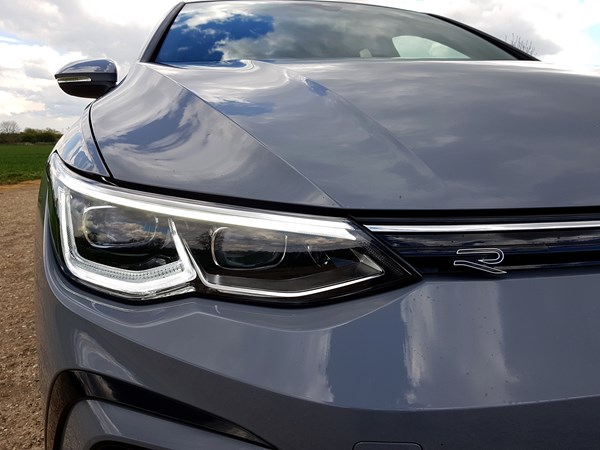
Out and about I had to wait until quite late as when I write this, we are around the longest day. Even at 11.00 pm it’s still fairly light so I waited a few days for a really cloudy and overcast evening. The ‘IQ’ system is very much like having a fully interactive lighting system on board. The lights follow the road depending on the conditions and it’s akin to fully intelligent lighting. On high beam when you get to a certain threshold, the lights seem to brighten up somewhat. I love it and as a ‘specs’ wearer [and frequent night time driver], having the best premium options for night vision is a big plus for me. When choosing specs, I now always insist on Zeiss ‘Drive Safe’ varifocals. Again, the difference between these and ‘normal’ varifocals is a ‘chalk n’ cheese’ scenario. IQ for me gets the BIG thumbs up.
I did manage to find a guy on YouTube who has made this video as trying to describe the system, doesn’t really do it justice. There’s no commentary and it was filmed in EU – but watch it, and you’ll get the idea of what’s going on.
Update 4: Buying, owning or hiring your Golf
Want a new Volkswagen Golf? Percy Lawman runs you through your options…
With lockdown over [well at least for the time being], things can start to get back to normal. Whilst Covid was a hugely unwelcome addition to everyone’s lives during the last 18 months being housebound has given many people a boost in their bank balance.
My own step-daughter reckons she has saved around £800 a month on a ‘Normal’ leisure month. That’s a big saving, and like many people out there, there has been talk of spending this on a nice new car.
So, what better a time to treat yourself to a new Golf Mk8.
Car owning has many different flavours these days. The old-school ways of just buying and owning that car are well and truly gone. Today, you have a multitude of choices of how to get your hands on that new chunk of metal.
In this update, we’ll take a look at the options that are open and check over a handful of pricing examples.
Where possible, we’ll include links to deals which will be correct at the time of originally publishing this article, but as the car market is a very fluid place to be, deals may not stick around for very long so it’s worth keeping your eye on the ball on a regular basis.
So grab yourself a calculator and start drooling.
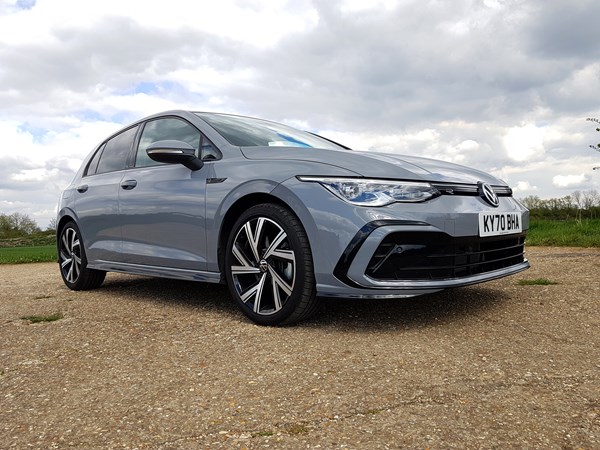
Buying a car outright
The original way of buying. Nothing more, nothing less. The idea of walking into a dealership with a bag full of cash and asking for the best deal was always a quite unique affair. Whilst dealers are sure to be pleased to see you, there’s no point in walking into the dealership with 30k in hard cash.
We live in a modern society and apart from you presenting yourself as a huge security risk as you sit on the bus with wads of cash hanging out of a plastic shopping bag, dealers are very well setup to perform all transactions electronically. It’s much safer and on top of that, you are very well protected.
For credit-card owners, buying on your card has many advantages. ‘Section 75 of the Consumer Credit Act’ protects buyers for purchases between £100 and £30,000. This means if in the unlikely event something goes wrong [say the dealer goes insolvent and has taken payment], then you are covered up to the maximum of £30,000. It’s akin to having a cast-iron insurance policy.
Parkers Tip – If you decide to purchase using a credit card, remember to pay off the balance quickly [or latest before the end of the following month]. If not, you’ll be hit by some pretty hefty APR rates as most credit cards have very high APR rates [up to 30% is not uncommon] which could really wipe out the the savings.
We’ve a comprehensive rundown of Parkers top buying tips which buyers may find useful before marching off to do a deal.
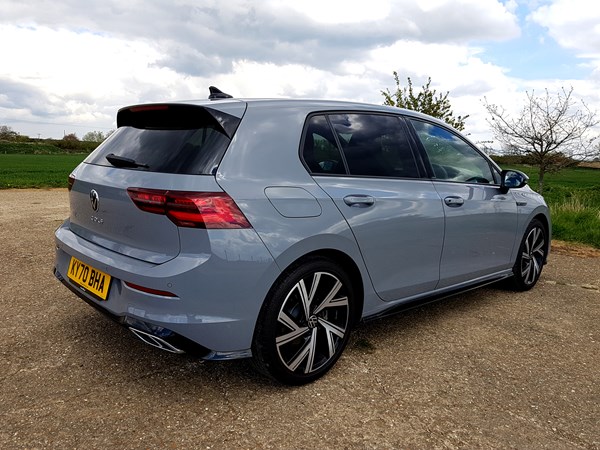
Buying from a main franchised dealer
Here you get all main dealer benefits, thrills and peace-of-mind. Chances are though, you won’t find the lowest actual price for the car. Main dealers effectively represent the manufacturer and are geared up to sort out any issues quickly and effectively. VW has many main franchised dealers up and down the country. You can link here to arrange to view, test drive and buy your car.
Buying from an independent dealer or internet outlet
Here’s where you’ll find the keenest prices. Independents don’t have the same outlay that main dealers have, so can offer much keener outright ‘Buy’ prices than main dealerships. Whilst this looks to be the magic bullet, not all independents are the same. Most dealers you’ll have no trouble with but you’re unlikely to get the same level of attention to detail of a main dealership. We’d say buy on credit card from an independent as you’ll be covered should something go wrong. ‘Cash Buy’ prices can save you quite a lot on the RRP and deals are frequent although can often change. You may need to chase around to get the best deal.
As an example, we found the exact same model Golf Mk8 that we are running, [the 1.5 TSI 150 R-Line Manual without any options] from Nationwide Cars with an RRP saving of just under £4000. Options can be added as required.
Car leasing – Personal Contract Hire [PCH]
We don’t always have the cash-on-hand to buy a new car every three years – that’s where car leasing (or Personal Contract Hire – PCH) comes in. In essence, it’s a ‘Renting Agreement’ and when the rental period is over – you hand the car back. Car leasing offers an alternative to purchasing a car up-front or arranging finance. You can adjust the length of the term, your expected annual mileage and the upfront amount you pay (known as the Initial Payment) to find a monthly payment that suits you.
On Parkers, we’ve teamed up with leasing experts ‘Zen Auto’ who are the home of all things personal contract hire – or PCH as it’s sometimes known. You can check out the very latest leasing deals on the Golf Mk8 here.
Car leasing – Personal Contract Purchase [PCP] ‘Purchase’ is the key word here. With PCP you have the option buy the car at the end of the agreement. PCP stands for Personal Contract Purchase. It works by spreading the price of a car across a deposit, a series of monthly payments, and an optional final payment. Typically, a PCP finance agreement lasts between 24 and 48 months. PCP deals are in abundance at main franchised dealerships.
Unlike with a bank loan – where you pay for the whole cost of the car over the contract – with PCP you just pay for the depreciation. That’s the difference between the initial price and what the car is expected to be worth (the Guaranteed Minimum Future Value GMFV) when you hand it back.
This means that you can run a brand-new car for an affordable monthly payment with the option to simply hand the keys back with nothing left to pay at the end of the contract – provided the car is in good condition, below the agreed mileage limit and has been serviced as stipulated by the manufacturer.
If you want to buy the car outright, however, you simply make the optional final payment. And then it’s yours.
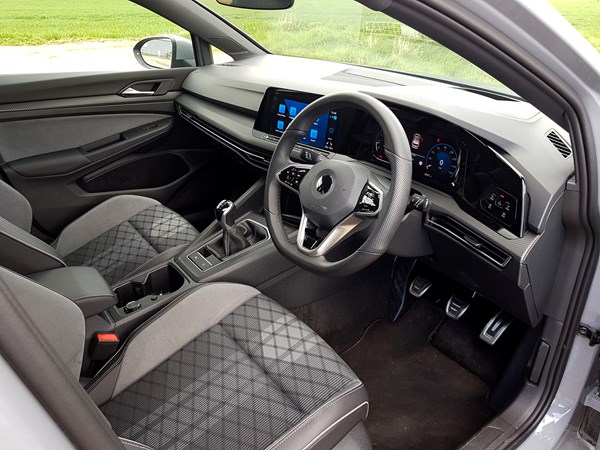
Cash loan from a finance provider
In the past, many people would consider an independent loan from a bank or alternative loan outlet. This purchase method is still valid for some as the idea of owing your car outright still has that big zing factor about it. There’s are very large choice of lenders in the market place, but consumers should aim for a loan that has a low APR as the first item in the checklist.
Buying your car and personally owning it has advantages in that [unlike PCP], there no limitation of the number of miles you cover. Effectively you buy the car and it’s yours to keep.
I’m a bit old-school here and every long-termer than I’ve had the pleasure in running, I’ve sourced some pretty keen personal finance deals. *Whilst we can’t advise on individual deals as everyone’s circumstances are different, we’ve found these very keen deals from outlets such as Tesco Bank.
Tesco Bank has always been a firm favourite here on Parkers, consistently offering the consumer a low APR repayment [still 3%]. Using their online loans calculator we found a great low APR deal on a loan of £22,000 over a 5 year period.
Loan Amount – £22,000
APR – 3%
Monthly Payments – £394.91
Loan Period – 5 years [60 months]
Total Repayable – £23,694.60
In essence you choose the amount to borrow, loan period and the agreed payment per month then the company lend you the cash and you pay it back as per your agreement. In most cases [once the loan is approved], you’ll have your money fairly quickly. It’s then up to you to do the donkey work and begin your search for a new car.
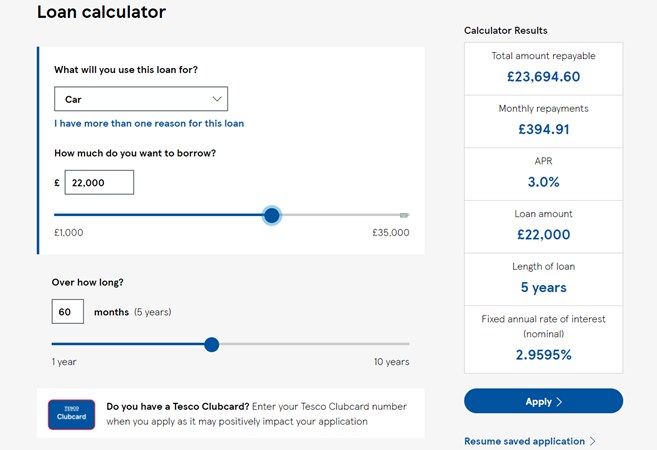
*Deals are correct at time of publication. Everyone’s financial circumstances are different and credit is not always available – Parkers cannot recommend a deal for you specifically. These deals are indicative examples of some packages available this week.
Check out our full Parkers guide on PCH Leasing here
Check out our full Parkers guide on PCP Leasing/Purchase here
Update 5: Second opinion
Parkers editor Keith Adams gets behind the wheel for a couple of weeks and tries to get under the skin of the Golf Mk8
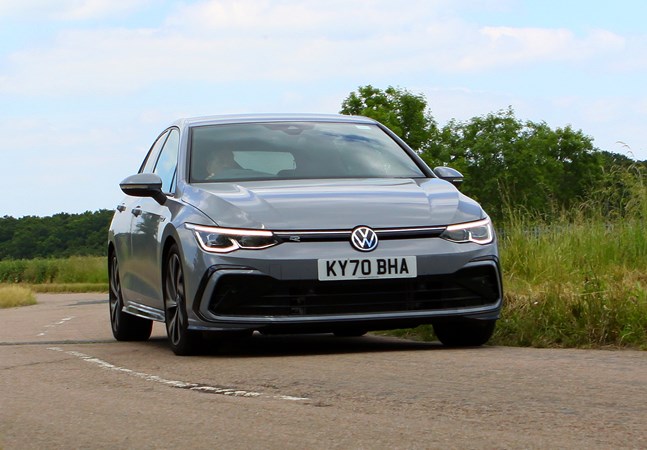
Thank you to Percy for letting me spend some time behind the wheel of his Golf long-termer. I have to say that I’m a big fan of the Golf Mk7, and so far have felt a little underwhelmed by the new one in comparison. That’s not because the newer car isn’t any good – it is, as we’ve already seen – but that the old was was just about brilliant in every aspect.
So when I first drove the Mk8, I was left with the impression that in most areas they’ve not improved it, and some of it has been changed for change’s sake. So, a refresher was obviously long overdue. As per normal, the best way for me to test a car is to head to home in Cumbria and spend some time getting to properly know it – that run encompasses busy motorways, sinuous B-roads and challenging fell roads. Not a single aspect of the car wouldn’t be tested by the end of it.
So, what did I end up finding out in the 800 miles I had it for? Well, the performance and economy are outstanding. That 1.5-litre engine delivers ample pace, and yet doesn’t struggle to deliver 50mpg in real-world driving. The high-speed refinement is also excellent, making this the perfect long-distance cruiser. On more challenging roads, the firm ride didn’t please, but the damping is good, and handling is excellent. This, you already know.
The interior was where I had my biggest beef, and although I love the digital dashboard and large infotainment screen, I still struggle to appreciate the sluggishness of the system. The touchpads, too, continue to be a pain, and although I got used to them – they really aren’t a patch on a more traditional high quality rotating knob.
So, would I have one over a Mk7? If you’d asked me before I borrowed Percy’s I’d have had no without hestitation. But the more I drove the Mk8, the more I appreciated its excellent driving position, performance and overall refinement and efficiency. Interestingly, I’ve since jumped into a Mk7 again, and all of a sudden, it’s feeling a little bit old inside. Never thought I’d hear myself say that!
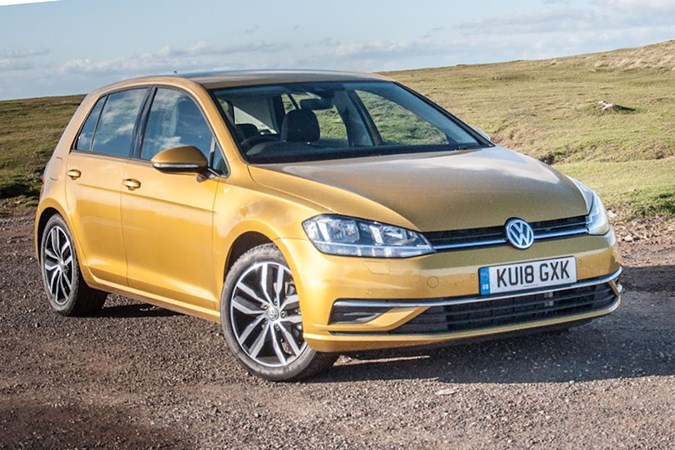
Update 6: Round-up – plus what we like and don’t like
So, after running our Golf Mk8 during the best part of 2021, it’s time for Percy Lawman to say goodbye and look at some of the things we like and, on the flipside, some features that just quite didn’t hit the mark.
What we like
We love the intelligent IQ LED Matrix lighting system. It’s an expensive additional option at £1750 but fully worth the outlay. In operation, it opens up the road akin to having a curtain opening up on the stage just as a show begins. It’s great tech and works extremely well.
The rear-view camera is highly capable with great resolution and is crystal clear. It’s a real bonus when parking or manoeuvring in and out of tight situations.
The 18 inch ‘Bergamo’ alloys add just that bit extra bite on handling. They look great and don’t induce much in the way of extra road noise. An option that looks great and a worthy addition.
The 150hp manual six-speed engine is a joy to use. After about 5000 miles its loosened up nicely and delivers plenty of punch and very slickly when required.
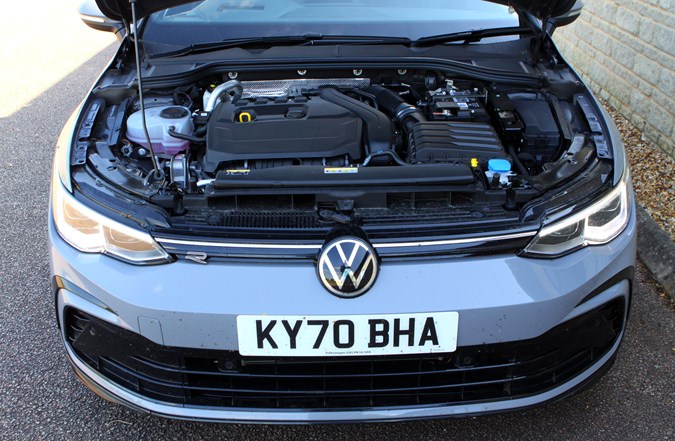
What we don’t like
I’m not a fan of the automated lane departure system. It’s far too ‘fussy’ and gives too many ‘false positives’ [twitching at the wheel] even when you’re in or near the centre of the road. Yes, you can turn it off but have to do this manually each time you start the car.
Fuel economy is generally OK, but I couldn’t hit the published WLTP figures. Put your right foot to good use and the real-world economy drops considerably. On some spirited driving sessions, 25mpg was more like the average. On testing, going from a 60mph to a 75mph cruise decreased consumption on average by around 20mpg.
The 10.0-inch ‘Digital Cockpit Pro’ is a real love/hate relationship. We found it a little slow. Some menus are buried deep in the digital abyss and not where you’d expect to find them. Move a finger close to ‘two’ functions and the system will get easily confused. For instance, the volume controls are situated very close to the touchscreen. Some functions really require you to stop the car first. Trying to work through multiple menus, accurately when driving can prove very challenging.
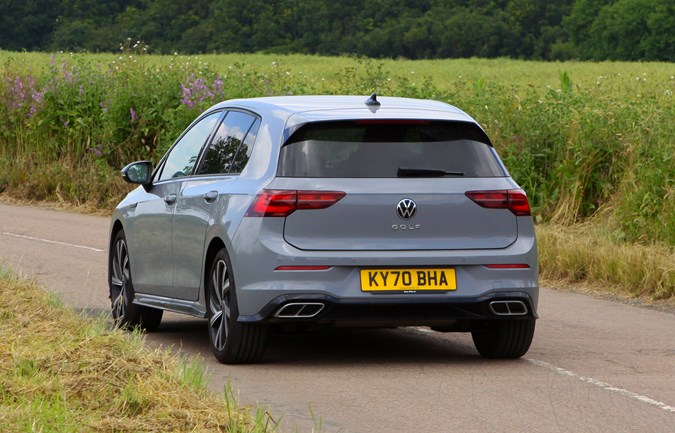
Rounding things up
All-in-all, the Golf Mk8 was a real pleasure to run. On the whole, it was a pretty positive experience. We had no reliability issues although because of Covid restrictions, some months of ownership meant that we didn’t cover the kind of mileage normally associated with a longer-term test vehicle. Saying that, we completed just over 5,000 miles which was more than ample to get a good feeling on how the Golf performed.
Passers-by had a marmite experience with the ‘Moonstone Grey’ colour scheme. I loved it and thought it was pretty cool. The larger 18-inch Bergamo alloy wheels really set the car off. It looked great, sitting sleek and low.
Eagle eyed Parkers users may also see that we’ve now split out some of the other body styles of the Golf Mk8. Our R-Line derivative covers the ‘hatchback’, but there’s a superb choice of alternatives like the Golf GTD which is a ‘hot’ diesel version. The Golf GTE which is practical and posh plug-in hot hatch. The Golf GTi which has been a ‘hot-hatch’ favourite since its incarnation in the late 1970s and finally the tarmac-shredding supercar slaying Golf R.
Buy a new, nearly new or used VW Golf
See all the current VW Golf Hatchback deals on Parkers Cars For Sale
See all the current VW Golf GTD deals on Parkers Cars For Sale
See all the current VW Golf GTE deals on Parkers Cars For Sale
See all the current VW Golf GTI deals on Parkers Cars For Sale
See all the current VW Golf R deals on Parkers Cars For Sale
Percy Lawman – 4 October 2021



